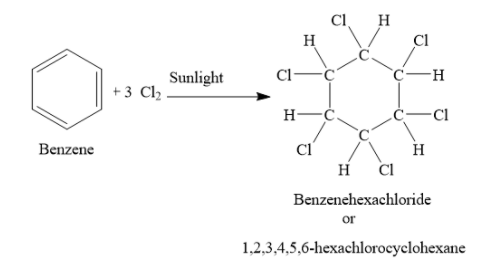
Write full name of B.H.C.
Answer
499.5k+ views
Hint: B.H.C contains carbon, hydrogen and chlorine. It is obtained from benzene. The chemical formula of B.H.C is
Complete answer:
The full name of B.H.C. is benzene hexachloride or 1,2,3,4,5,6-hexachlorocyclohexane. It is obtained by the addition of chlorine to benzene in presence of light. For this reaction to occur, oxygen and substitutional catalysts should be absent.

The chemical formula of B.H.C is
Lindane (also called Gammexane) is one of the stereoisomers of B.H.C. Lindane is an insecticide. It is used to prevent crops from insects. Burning, stinging or redness of skin are some of the side effects of lindane.
Note: B.H.C is called benzene hexachloride or 1,2,3,4,5,6-hexachlorocyclohexane or gammexane. It is obtained by addition of three chlorine molecules to one benzene molecule, in presence of sunlight.
Complete answer:
The full name of B.H.C. is benzene hexachloride or 1,2,3,4,5,6-hexachlorocyclohexane. It is obtained by the addition of chlorine to benzene in presence of light. For this reaction to occur, oxygen and substitutional catalysts should be absent.

The chemical formula of B.H.C is
Lindane (also called Gammexane) is one of the stereoisomers of B.H.C. Lindane is an insecticide. It is used to prevent crops from insects. Burning, stinging or redness of skin are some of the side effects of lindane.
Note: B.H.C is called benzene hexachloride or 1,2,3,4,5,6-hexachlorocyclohexane or gammexane. It is obtained by addition of three chlorine molecules to one benzene molecule, in presence of sunlight.
Latest Vedantu courses for you
Grade 11 Science PCM | CBSE | SCHOOL | English
CBSE (2025-26)
School Full course for CBSE students
₹41,848 per year
Recently Updated Pages
Express the following as a fraction and simplify a class 7 maths CBSE

The length and width of a rectangle are in ratio of class 7 maths CBSE

The ratio of the income to the expenditure of a family class 7 maths CBSE

How do you write 025 million in scientific notatio class 7 maths CBSE

How do you convert 295 meters per second to kilometers class 7 maths CBSE

Write the following in Roman numerals 25819 class 7 maths CBSE

Trending doubts
Give 10 examples of unisexual and bisexual flowers

Draw a labelled sketch of the human eye class 12 physics CBSE

Differentiate between homogeneous and heterogeneous class 12 chemistry CBSE

Differentiate between insitu conservation and exsitu class 12 biology CBSE

What are the major means of transport Explain each class 12 social science CBSE

Draw a diagram of a flower and name the parts class 12 biology ICSE




